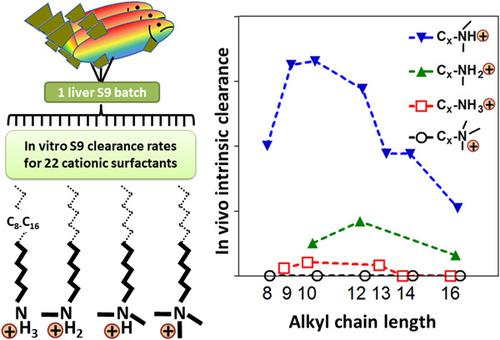当前位置:
X-MOL 学术
›
Environ. Toxicol. Chem.
›
论文详情
Our official English website, www.x-mol.net, welcomes your feedback! (Note: you will need to create a separate account there.)
Biotransformation Potential of Cationic Surfactants in Fish Assessed with Rainbow Trout Liver S9 Fractions
Environmental Toxicology and Chemistry ( IF 4.1 ) Pub Date : 2021-08-11 , DOI: 10.1002/etc.5189 Steven T J Droge 1 , James M Armitage 2 , Jon A Arnot 3 , Patrick N Fitzsimmons 4 , John W Nichols 4
Environmental Toxicology and Chemistry ( IF 4.1 ) Pub Date : 2021-08-11 , DOI: 10.1002/etc.5189 Steven T J Droge 1 , James M Armitage 2 , Jon A Arnot 3 , Patrick N Fitzsimmons 4 , John W Nichols 4
Affiliation

|
Biotransformation may substantially reduce the extent to which organic environmental contaminants accumulate in fish. Presently, however, relatively little is known regarding the biotransformation of ionized chemicals, including cationic surfactants, in aquatic organisms. To address this deficiency, a rainbow trout liver S9 substrate depletion assay (RT-S9) was used to measure in vitro intrinsic clearance rates (CLint; ml min–1 g liver–1) for 22 cationic surfactants that differ with respect to alkyl chain length and degree of methylation on the charged nitrogen atom. None of the quaternary N,N,N-trimethylalkylammonium compounds exhibited significant clearance. Rapid clearance was observed for N,N-dimethylalkylamines, and slower rates of clearance were measured for N-methylalkylamine analogs. Clearance rates for primary alkylamines were generally close to or below detectable levels. For the N-methylalkylamines and N,N-dimethylalkylamines, the highest CLint values were measured for C10–C12 homologs; substantially lower clearance rates were observed for homologs containing shorter or longer carbon chains. Based on its cofactor dependency, biotransformation of C12–N,N-dimethylamine appears to involve one or more cytochrome P450–dependent reaction pathways, and sulfonation. On a molar basis, N-demethylation metabolites accounted for up to 25% of the N,N-dimethylalkylamines removed during the 2-h assay, and up to 55% of the removed N-methylalkylamines. These N-demethylation products possess greater metabolic stability in the RT-S9 assay than the parent structures from which they derive and may contribute to the overall risk of ionizable alkylamines. The results of these studies provide a set of consistently determined CLint values that may be extrapolated to whole trout to inform in silico bioaccumulation assessments. Environ Toxicol Chem 2021;40:3123–3136. © 2021 The Authors. Environmental Toxicology and Chemistry published by Wiley Periodicals LLC on behalf of SETAC.
中文翻译:

用虹鳟鱼肝 S9 组分评估的鱼类中阳离子表面活性剂的生物转化潜力
生物转化可以显着降低有机环境污染物在鱼体内积累的程度。然而,目前,关于水生生物中电离化学物质(包括阳离子表面活性剂)的生物转化知之甚少。为了解决这一缺陷,虹鳟鱼肝脏 S9 底物消耗试验 (RT-S9) 用于测量22 种不同烷基的阳离子表面活性剂的体外内在清除率 (CL int ; ml min –1 gliver –1 )带电氮原子的链长和甲基化程度。季N,N,N-三甲基烷基铵化合物均未表现出显着清除。观察到N、N的快速清除对N-甲基烷基胺类似物测量了-二甲基烷基胺和较慢的清除率。伯烷基胺的清除率通常接近或低于可检测水平。对于N-甲基烷基胺和N,N-二甲基烷基胺,C 10 –C 12同系物的 CL int值最高;对于含有较短或较长碳链的同系物,观察到明显较低的清除率。基于其辅因子依赖性,C 12 - N,N-二甲胺的生物转化似乎涉及一种或多种细胞色素 P450 依赖性反应途径和磺化。在摩尔基础上,N-去甲基化代谢物占 2 小时测定期间去除的N,N-二甲基烷基胺的高达 25%,占去除的N-甲基烷基胺的高达 55% 。这些N-去甲基化产物在 RT-S9 测定中比它们衍生的母体结构具有更高的代谢稳定性,并且可能导致可电离烷基胺的总体风险。这些研究的结果提供了一组一致确定的 CL int值,这些值可以外推到整条鳟鱼,以提供计算机生物累积评估的信息。环境毒物化学2021;40:3123–3136。© 2021 作者。Wiley Periodicals LLC 代表 SETAC 出版的Environmental Toxicology and Chemistry 。
更新日期:2021-08-11
中文翻译:

用虹鳟鱼肝 S9 组分评估的鱼类中阳离子表面活性剂的生物转化潜力
生物转化可以显着降低有机环境污染物在鱼体内积累的程度。然而,目前,关于水生生物中电离化学物质(包括阳离子表面活性剂)的生物转化知之甚少。为了解决这一缺陷,虹鳟鱼肝脏 S9 底物消耗试验 (RT-S9) 用于测量22 种不同烷基的阳离子表面活性剂的体外内在清除率 (CL int ; ml min –1 gliver –1 )带电氮原子的链长和甲基化程度。季N,N,N-三甲基烷基铵化合物均未表现出显着清除。观察到N、N的快速清除对N-甲基烷基胺类似物测量了-二甲基烷基胺和较慢的清除率。伯烷基胺的清除率通常接近或低于可检测水平。对于N-甲基烷基胺和N,N-二甲基烷基胺,C 10 –C 12同系物的 CL int值最高;对于含有较短或较长碳链的同系物,观察到明显较低的清除率。基于其辅因子依赖性,C 12 - N,N-二甲胺的生物转化似乎涉及一种或多种细胞色素 P450 依赖性反应途径和磺化。在摩尔基础上,N-去甲基化代谢物占 2 小时测定期间去除的N,N-二甲基烷基胺的高达 25%,占去除的N-甲基烷基胺的高达 55% 。这些N-去甲基化产物在 RT-S9 测定中比它们衍生的母体结构具有更高的代谢稳定性,并且可能导致可电离烷基胺的总体风险。这些研究的结果提供了一组一致确定的 CL int值,这些值可以外推到整条鳟鱼,以提供计算机生物累积评估的信息。环境毒物化学2021;40:3123–3136。© 2021 作者。Wiley Periodicals LLC 代表 SETAC 出版的Environmental Toxicology and Chemistry 。


























 京公网安备 11010802027423号
京公网安备 11010802027423号